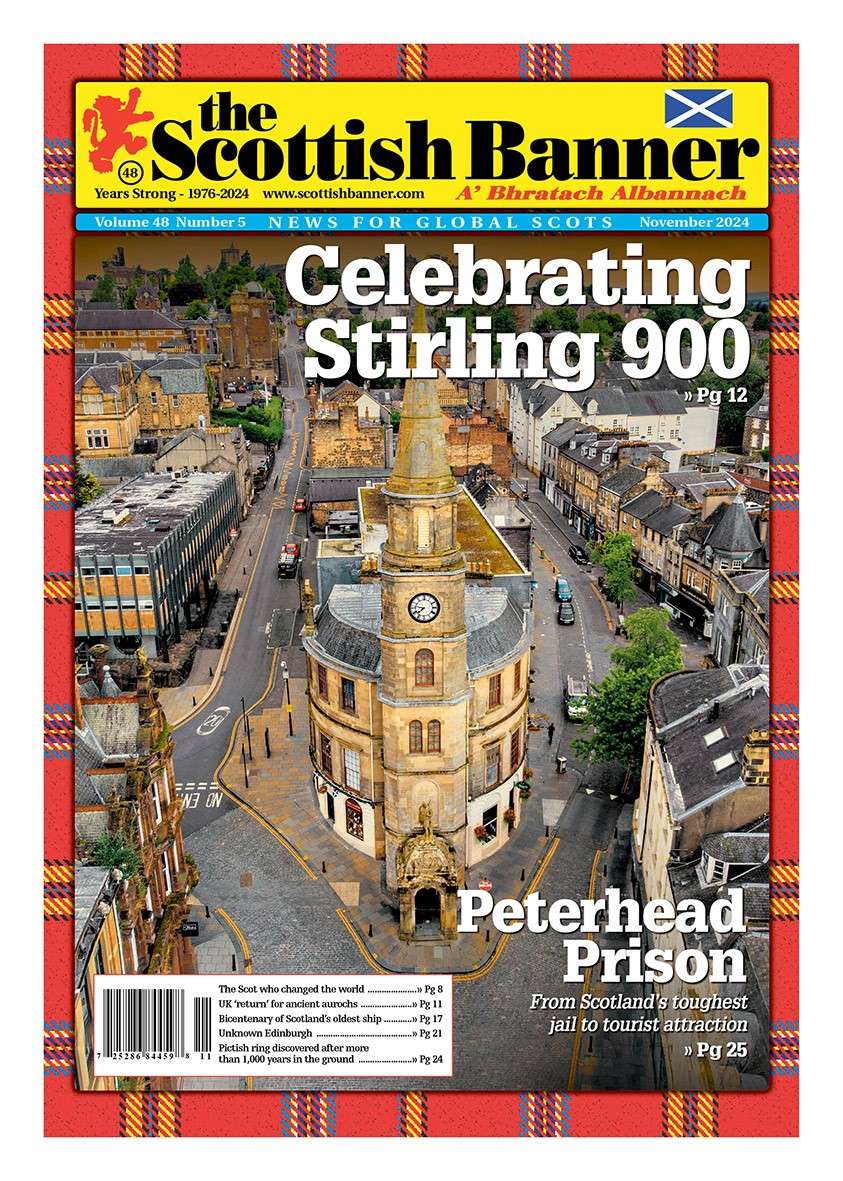November 2024 (Vol. 48, Number 05)
The Banner Says…
Scots at War
-

Stirling 900-King Street, Stirling. Photo: Fraser MacDonald.
November is often a busy month for many with St Andrews Day events taking place, US Thanksgiving, springtime and all the events coming on in the Southern Hemisphere and the festive season just about to start. However, for one minute on one day this month I always stop and reflect. On the 11th hour, on the 11th day, on the 11th month, I will join so many people around the world as they too pause and remember all those who gave their lives in service to their country.
Domestic battles
Scots have never been one to back down from conflict and Scotland itself has an incredible, tragic and mighty history of warfare. From years of ‘domestic battles’ where Scots fought on home ground with the English, or amongst themselves, to incredible acts of bravery in international conflicts Scots have been there. One of Scotland’s most celebrated battles must be the Battle of Bannockburn which took place in June 1314 and saw Robert the Bruce and his men defeat the much larger English forces in Stirling. The battle remains a symbol of Scotland’s fight for independence today.
The Battle of Culloden in 1746 was the final Jacobite rising and the last battle ever fought on Scottish or British soil. The Jacobites were no match for the Hanoverian army with the battle lasting not even an hour, and the Scottish army was brutally crushed with over 1,200 dead within minutes. Anyone who today visits Culloden Battlefield cannot help but feel moved by this hallowed ground which still today weeps for those lost.
Ladies From Hell
On the battlefields of Europe during WW1 the words ‘Die Damen aus der Hölle’ could heard be spoken. This German phrase translates to ‘Ladies from Hell’ which was the nickname German troops gave to the revered, and kilted, Scottish Highland battalions. Scottish regiments were especially feared as an opposing force, however tragically an estimated 20 percent (nearly 150,000) of Scots who went to war in WW1 never came home, leaving a lasting and immense scar across Scotland. However, the reputation of the ‘Devils in Skirts’ remains part of European military folklore.
Scottish troops played alarge role in both World Wars and also the world’s more recent conflicts and they today are respected the world over. Visitors to Edinburgh can visit the Scottish National War Memorial which commemorates the Scots who lost their lives in conflicts. This moving memorial was built in the 1920s and is located within the walls of Edinburgh Castle, its displays the Roll of Honour for Scots, which names every Scottish casualty killed in conflicts. Several craftspeople were commissioned to create sculptures and stained glass for the memorial, which is today regarded as one of Scotland’s most sacred buildings.
In this issue
Scottish Australian Archibald Clark Kerr was a key figure in British foreign policy and played a major role in bringing WW2 to a close and bringing many Scots and others home. He also played a significant role in the founding of NATO, and we are happy to shine a light on him this month.
This year the historic city of Stirling is celebrating the incredible milestone of its 900th anniversary. Founded by King David I in 1124, the Royal Burgh of Stirling is one of the oldest burghs in Scotland. Since then, the now city has witnessed some incredible moments in Scottish history. It is today a great city to visit with much to do and a programme of events and celebrations are taking place until April 2025.
Another city which is celebrating its 900th anniversary is Edinburgh. Edinburgh is Scotland’s most visited city and offers so much for visitorsto explore. It has stunning views and incredible history around every corner with visitors experiencing the famous castle, Royal Mile and more. This month we highlight some of the lesser-known locations, which you can hopefully incorporate on your next visit to the Scottish capital.
Instrument of War
Think bagpipes and most will quickly link to Scotland. The pipes of course are a global instrument but for Scots they do take on a much deeper cultural and historical importance. One thing the Scottish regiments did have to boost morale during unfathomable times was bagpipes. Pipers served across all the regiments and not only were a great source of moral boosting for the troops, but the haunting sounds also put fear in the enemy. The British Army however did not allow playing of bagpipes during combat because they were thought to expose the piper and troops to danger. The bagpipe is the only musical instrument ever to be considered as a tool of warfare. Scots have long history with the bagpipes used during warfare dating back hundreds of years.
Today, the pipe bands remain deeply associated with Scottish military traditions and still linked to several military institutions. Regardless of where you find yourself this month, I hope you find time to pause and remember all the men and women who gave their all, for all of us. Lest we forget.
Do you have you any comments from the content in this month’s edition? Share your story with us by email, post, social media or at: www.scottishbanner.com/contact-us
#ScottishBanner, #TheBanner #NewsForGlobalScots
The Scottish Banner is more reliant than ever on our readers helping us to provide you with our unique content by buying a copy of our publication, regardless if by print or digital subscription or at a retail outlet.
We appreciate your support and hope you enjoy this edition.
